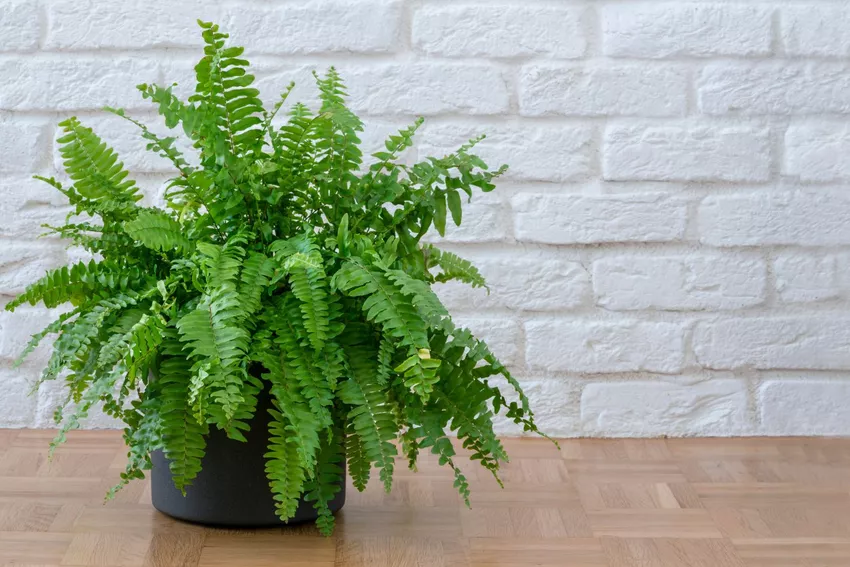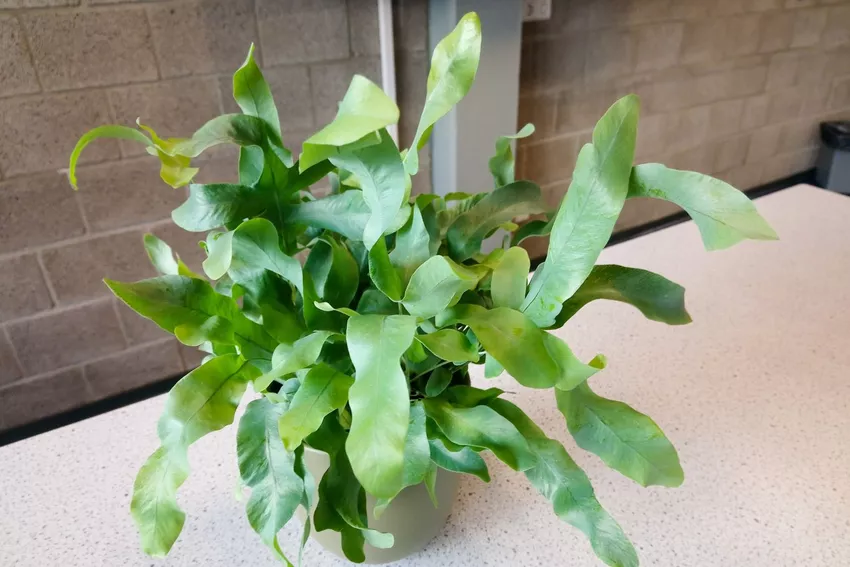Ferns are typical forest plants for most people, growing in the shade of the trees on the damp ground. Many types of ferns can also be kept as indoor plants.

If you want to keep a fern as a houseplant, you should first choose the right species, because not all ferns are house ferns. Fern species from the tropics are usually best suited. Here we present the most beautiful indoor ferns and their special features.
Ferns as indoor plants: The most beautiful species
Ferns are among the oldest plants in the world and are found almost all over the world. In total there are about 12,000 species of ferns. Here you can find them in their natural habitat in the forest, but also as indoor plants. The indoor ferns are usually tropical ferns that require high humidity. Here we show which ferns are suitable as indoor plants and what makes them so special.
Nest Fern
The tropical nest fern (Asplenium nidus) has slow growing, entire, glossy leaves and no leaflets. In nature it grows epiphytically, i.e. perched on trees without direct contact with the ground. As a houseplant, the nest fern is best at 18 to 25 °C in a somewhat shady and humid location. It needs a substrate mixture with 50% sand. With its funnel-shaped leaves, the fern absorbs water and nutrients in the heights of the trees, which is why it is also poured directly into the leaf funnel as a houseplant.

Tip: A close relative of the nest fern is the spleen fern, Asplenium dimorphum. It produces metre-long feathered fronds and is very resilient.
Sword Fern
The sword fern (Nephrolepis ex altata) is considered to be very hardy and easy to care for. It has pinnate or compound green leaves that are up to 80 cm long. These hang decoratively over the edge of the pot in room culture. In nature, the fern can be found both growing on the ground and as an epiphytic plant in the trees.Indoors, it needs a bright spot without direct midday sun at year-round temperatures of 18 to 20 °C. High humidity is very beneficial, which is why the bathroom is often a good choice. The soil in which the sword fern is planted should store water well and have a loose structure. The sword fern can reach heights of up to 90 cm. There are different varieties with wavy, curly or variegated leaflets.

Tip: Proven varieties of heavy fern are:
- 'Teddy Junior': Particularly vigorous
- 'Boston Midget': Remaining Smaller
- ‘Whitmannii’: densely curled foliage, somewhat more sensitive
- ‘Bornstedt’: Just as densely curled foliage, similar to ‘Whitmannii’
Maidenhair Fern
A rather smaller representative is the maidenhair fern (Adiantum capillus-veneris), which is also called Venus hair. The shoots are thin and hair-thin, usually dark brown and shiny, which is why they resemble human hair. Rounded, fanned, delicate light green leaflets sit on the shoots. In the apartment, the maidenhair fern needs a semi-shady location at temperatures of 20 to 25 °C in summer. In winter it can be a bit cooler at around 18 °C. High humidity and well-drained, slightly acidic soil are essential for he althy growth. In good conditions, the fern fronds can reach a length of 60 cm.

Tip: There are various other species and varieties of the genus Adiantum that are used as indoor ferns. Adiantum reniforme bears erect, loose fronds on angular stems. Adiantum raddianum has an amazing diversity of varieties and grows densely bushy.

Hardfern
The bifurcated staghorn fern (Platycerium bifurcatum) has particularly unusual fronds. They are gray-green, leathery, and branch out at the top to resemble deer antlers. The leaves are quite firm and grow upright to overhanging. In addition, different types of so-called mantle leaves are formed. They grow close to the ground and, like a layer of mulch, protect the fern from drying out. Over time, they turn brown and die, allowing nutrients into the soilto be led back. These mantle or niche leaves have no spores, so they are not intended for reproduction.
A half-shady, rather bright place without direct sun is suitable for the staghorn fern. The temperature should not drop below 16 °C in winter, year-round temperatures of around 20 °C are best. Orchid soil is ideal as a substrate for this epiphyte. Antler ferns can also be cultivated like bromeliads (Bromeliaceae) in hanging planters or on epiphyte trunks. The staghorn fern does not tolerate dry heating air well, nor leaves that are wet with water - it is therefore best to place water bowls in the appropriate room. In summer the substrate must always be moist, in winter it can become drier.

Tip: You can also bring different types of staghorn home with you. Platycerium wilhelminae-reginae Grows particularly branched and decorative.
Dwarf Tree Fern
As this fern develops an upright trunk up to 1 m high when old, the dwarf tree fern (Blechnum gibbum) reminds a little of a palm tree. The up to 1 m long fronds, which are green and feathery, arise from the trunk. The leaflets are again slightly wavy. In winter, the dwarf tree fern as a houseplant is kept slightly cooler at around 17 °C than in summer, when it prefers temperatures of 20 to 25 °C. Find a semi-shady place for the dwarf tree fern and plant it in loose, slightly acidic substrate. For example, you can mix a universal soil with our Plantura organic acidic soil. Our acidic soil is not only just right for hydrangeas (Hydrangea spec.), it can even be used to mix optimal substrates for ferns, many palm trees and magic bells (Calibrachoa ).

Sickle Fern
The fronds of the sickle fern (Cyrtomium falcatum) are simply pinnate. The individual leaflets are quite large and serrated on the edge. The glossy, dark green leaves are somewhat reminiscent of those of holly (Ilex), which is why the plant is also called holly fern or holly fern. The species remains quite small with a growth height of about 30 cm. The sickle fern tolerates cool temperatures of around 18 °C all year round, but can stand outside in a partially shaded and sheltered place in summer. In winter are lowTemperatures around 10 °C are no problem for him, in summer he needs regular watering. The Ilex fern is sensitive to too many nutrients. An acidic substrate is suitable for the sickle fern, such as our Plantura organic acidic soil, with a pH value between 4 and 6. Our certified organic soil is peat-reduced and can also be used for many other plants.

Tip: The punctiform or elongated, brownish structures on the underside of the fern leaves are the so-called sori. Here are the collected spores that are needed for the reproduction of the ferns.

Pellefern
With its unusual fronds, the round-leaved pellet fern (Pellaea rotundifolia) immediately catches the eye. It has small, rounded leaflets that have a leathery structure and are shiny dark green. It is also called button fern because of its appearance. The shoots grow creeping rather than upright. Because of the waxy coating of the leaves, less water evaporates and the fern easily survives even drier phases. In winter, the pellet fern usually sheds its leaves and should then be overwintered in a cool place at over 5 °C. The right location for the Pellefarn in summer is bright but not sunny, with temperatures of around 20 °C. As a substrate, the Pellefarn is content with normal potting soil. Excessive watering is a nightmare for this xerophytic plant: the root ball should dry out before watering again.

Tip: The crescent-shaped pellicle fern (Pellaea falcata) has longer leaves and grows larger than its round-leaved relative. Pellaea viridis is considered to be particularly resilient and sports decorative, black and red petioles.
Goldenpotted Fern
Another popular house fern is the gold-spotted fern (Phlebodium aureum). It comes from the tropical and subtropical regions of America. The name comes from the golden spore deposits on the underside of the leaves. The location for this beautiful fern must be warm, rather shady and very humid. The leaves can consist of only one or many leaflets, with the leaflets being entire. In summer, normal room temperatures of around 20 °C are ideal, in winter it should be somethingbe cooler. However, the temperature must not fall below 12 °C. A mixture of potting soil and orchid soil or pine bark is very suitable for the golden palm fern.

Tip: Interesting cultivars of the golden fern are 'Glaucum crispum' with ruffled pinnate leaves and 'Mandaianum' with wavy and ruffled pinnate leaves.

The right place for indoor ferns
In nature, ferns usually grow in forests. The light supply is not particularly high there. Therefore, indoor ferns like a location in the semi-shade or even in the shade. Direct sunlight should be avoided for all indoor fern species.
In addition, high humidity is usually beneficial, especially for fern species from the tropics and subtropics. As a suitable room for room ferns, the bathroom is usually a good choice. A well-drained potting soil, such as our Plantura organic universal soil, is usually suitable as a substrate. It has many important nutrients and remains structurally stable for a long time. Before planting, a drainage layer should be laid to prevent waterlogging. But of course it is important to always consider the individual requirements of the fern species.
Care for indoor ferns
Caring for the indoor fern requires regular watering in the first place. The root ball should always be kept moist during the growing season. However, waterlogging should be avoided, which is why the liquid in the cachepot must be removed after watering. In winter, watering can be reduced slightly and the soil is allowed to dry out. Most indoor ferns should also be sprayed with water from time to time. Indoor ferns in pot culture can be fertilized every two to four weeks during the growing season. A liquid green plant fertilizer is suitable for this, such as our Plantura organic room and green plant fertilizer. Our mainly organic liquid fertilizer is easily applied with the irrigation water under the large fern fronds. Ferns do not need to be fertilized in winter. When the indoor fern develops brown leaves, they can be cut off.

Tip: The most common mistakes in caring for indoor ferns are too much sunlight, too much or too little water and too much fertilizer. This can easily lead to rot in the center of the frondscome and they turn brown, or they dry up and get brown spots from the sunlight.
Indoor ferns are therefore not very difficult to care for. But there are other houseplants that don't need a lot of attention. We have put together the 10 easiest houseplants for you.